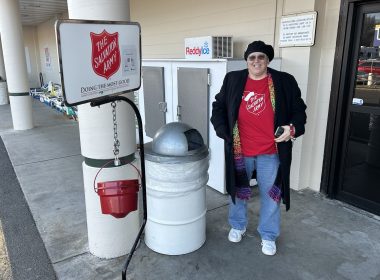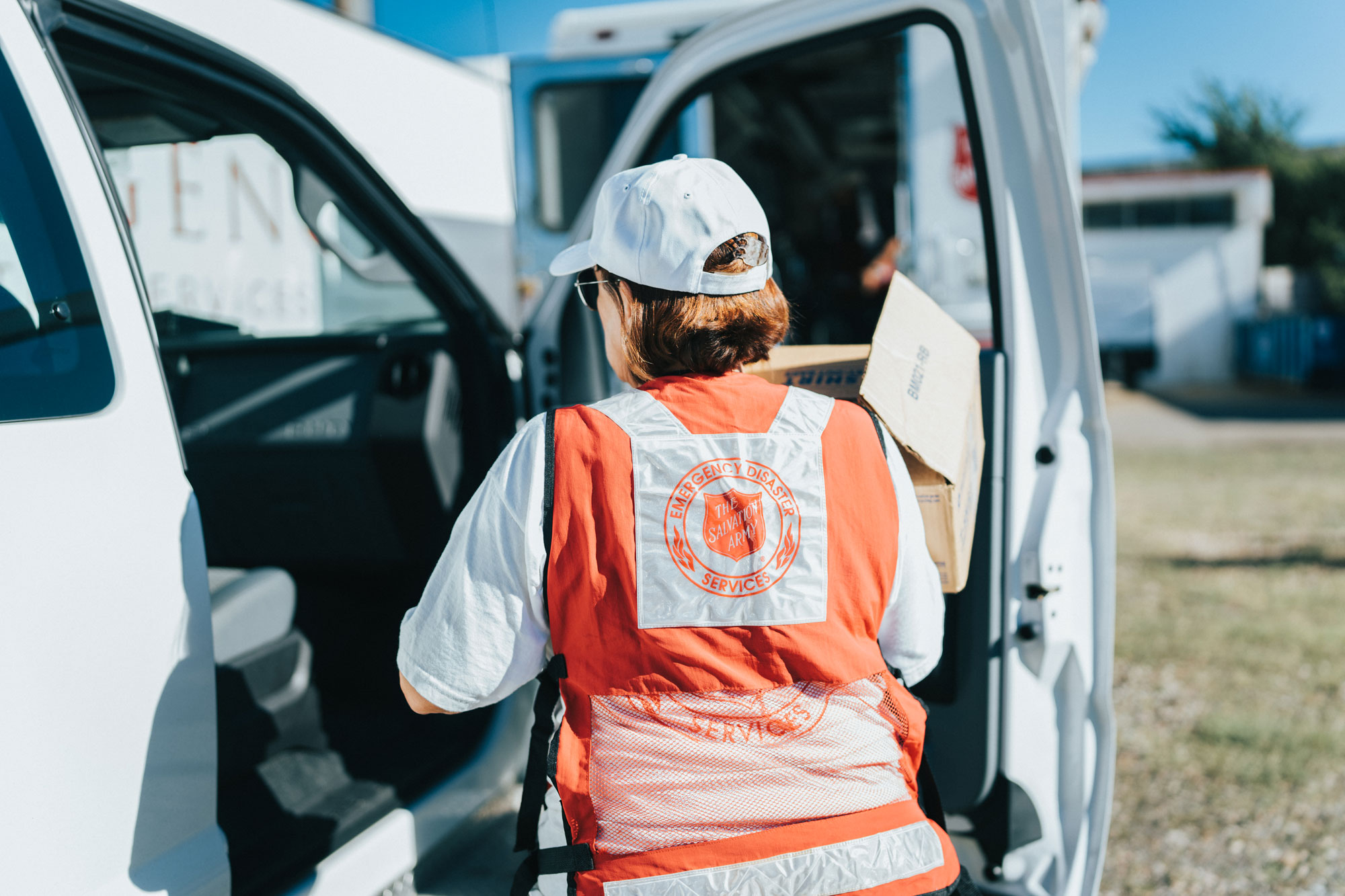Disasters happen, and when they do, they can change lives in an instant. Home loss, a lack of access to essential resources, and even health risks can all come from disasters and natural disasters. When disaster strikes, disaster response is the most important first step.
Let’s explore how you can fight disasters in the United States and support your fellow Americans when the unexpected happens.
What is Disaster Response in America—and Why Does it Matter?
Disaster response is the series of steps and protocols that take place in the event of a disaster. This term can refer to the response steps taken by the government after a disaster is declared, but it can also refer to the processes in place carried out by leading disaster response agencies, like The Salvation Army, and the many volunteers around the United States who support areas in need.
In America, there are many reasons why an area might need disaster response. Commonly, disaster responses are needed following a natural disaster or critical system failure. Wildfires, hurricanes, flooding and other natural disasters can devastate entire areas, placing people in danger and even forcing them from their homes. In 2022, there were 18 weather or climate-related disasters, with damages adding up to over $1 billion. That same year, there were 100 disasters declared in total.
How we respond to these disasters can play a critical role in how an area recovers and how many people experience extreme impacts.
The History of Disaster Response in America
The world is unpredictable, and we cannot always know when a disaster is going to hit. However, we do know that disasters—especially natural disasters—have impacted Americans since the U.S. first achieved its independence. The oldest traces of natural disasters and disaster relief go back as far as the early 1800s, when the government would step in to offer support as needed.
As the reality of disasters and the significant impact they can bring came to light, it became clear that more structured support was needed to ensure that areas and people in need could receive support in a more efficient manner. The Salvation Army was formed in 1865 in London and started its work in the United States in 1880. Most recently, the Disaster Relief Act of 1974 and the 1979 creation of FEMA made a lasting impact on how we approach disaster response in America.
Disaster Response Terms to Know
These terms are commonly heard in the disaster response space and are always good to know if you are looking to offer support.
Disaster Recovery Center
When a U.S. President declares a major disaster, a disaster recovery center will be established in the area. These centers provide nearby individuals with the opportunity to receive assistance if they need it, and they can also pair them with emergency services that can help them to navigate unbelievably challenging times.
Emergency Alert System
An emergency alert system is a system in place that is designed to convey relevant emergency information during times of crisis. These systems can include buildings and signs, television channels, radio stations, or even phone apps and text messages. They share emergency information when it is needed with people in a specific area.
Emergency Services
Emergency services are services that are designed to be deployed specifically in the event of an emergency or disaster. These services can cover everything from ensuring access to food and water all the way to helping entire areas rebuild or evacuate when something goes wrong.
Donations
Post-disaster donations are designed to collect specific types of items that can be used in the event of a crisis. The nature of donations can vary depending on the crisis and the needs of the individuals. However, donations most commonly include food, water, temporary shelters, first aid, and even clothing or blankets. Often, the best way the public can help is to provide monetary donations which allows the delivery of the exact relief supplies a community needs.
Evacuation
An evacuation occurs when an area is no longer safe for the people in the area, and steps must be taken to move them to a new location. While some evacuations are driven by individuals, like people getting in their car to flee from a wildfire, others are carried out with the support of volunteers and the government. The ultimate goal is to get people away from dangerous circumstances and relocate them to somewhere they can be safe in the meantime.
Watch
A “watch” in emergency services means that there is a likely risk of something happening that could result in a disaster. Watches are commonly referred to when speaking about natural disasters, which cannot be predicted 100 percent of the time. A watch may be activated if a storm is likely to hit an area, but not certain to do so. Activating a watch and sharing relevant information can help people in high-risk areas stay safe.
How The Salvation Army Fights Disaster in America
The Salvation Army is one of the oldest disaster relief groups in the United States of America, helping areas to recover for over 140 years. These are the main steps that The Salvation Army takes to help Americans when disaster arrives.
Communication
The Salvation Army is a voice for those in need, and placing a significant emphasis on communication. From making sure that information is easily accessible to those in disaster zones to keeping the general public informed when areas are in need, The Salvation Army makes sure that essential information always reaches the right people. This helps those who are impacted to access resources more effectively and makes sure everyone can pull together to help.
Emergency Preparedness
Disasters often happen without notice, and although we cannot always predict them, we can prepare for them. Only 48 percent of families have emergency plans for their own personal disaster response.
The Salvation Army is a leader in emergency preparedness and supports global efforts to ensure safe and effective disaster responses for areas all around the world, including the United States. From flooding and fires to hurricanes and war, The Salvation Army creates plans with its network of volunteers to help areas recover after a disaster following The Disaster Preparedness Handbook.
Get your copy of The Salvation Army’s Disaster Preparedness Handbook here.
Emergency Disaster Services
When a disaster hits, it can impact thousands of Americans immediately. Rapid response is essential to minimize challenges and save lives. The Salvation Army is committed to providing emergency response as quickly and effectively as possible.
Through these services, The Salvation Army provides everything from food and water to showers and blankets. The response is always driven by the needs of the area and those who are impacted, in combination with what is available. Providing support at every level is the ultimate goal.
Relief Programs
Relief programs can save lives, particularly for those who are displaced. Through dedicated programs, The Salvation Army supports impacted individuals through financial and resource relief to ensure their protection and security. These programs are largely driven by donations.
Emergency Shelters
Depending on the nature of the disaster, emergency shelters may be essential for supporting areas that are impacted. There are many reasons why emergency shelters are necessary. They can be used when homes are destroyed or severely damaged, and they can also be beneficial when the systems that support homes, like electricity and water, are damaged as well.
By providing and setting up emergency shelters, The Salvation Army gives people in need a place to go where they can trust that their essential needs are being met. These individuals will have a roof over their heads, stable temperatures, and access to key resources, like food, water and showers.
Care Coordination
Although The Salvation Army offers a significant amount of support, it really shines by bringing others together to offer support and care. In addition to its own programs, The Salvation Army partners with others to bring the right support to the right places. Ultimately, this means that more resources can come together to assist those in need as quickly and effectively as possible. By coordinating care and services, The Salvation Army brings order to chaos.
Emotional and Spiritual Support
Surviving a disaster and responding to a disaster can be deeply traumatic, and the emotional, spiritual and mental wounds that come with these occurrences can leave a lasting impact. Receiving emotional and spiritual support to address these instances can determine how someone recovers from them over time.
The Salvation Army recognizes that we all heal and feel supported in different ways, and it places a special emphasis on meeting the needs of individuals emotionally and spiritually. From lending a shoulder to cry on or listening to someone who needs to talk through what they have seen or experienced, this group offers trained care providers to help those in need recover more easily.
Long-Term Support
Disasters often happen fast, but the lasting impact is usually significant. When a disaster strikes, it can change an area for years—or even generations. Understanding this need, The Salvation Army also offers long-term disaster recovery efforts that are designed to help with ongoing needs as they arise.
To support long-term needs, The Salvation Army partners directly with local, state and federal governments. Together, they make a long-term recovery plan that is designed to include the essential components of rebuilding areas and supporting individual needs. Through financial assistance, donations, and volunteer programs, The Salvation Army partners with areas in need to support growth and recovery.
An excellent example of this was demonstrated in programs following Hurricane Katrina, where The Salvation Army continued to offer support for over 10 years.
How to Make a Difference in Disaster Response in America
If you are looking to leave a lasting positive impact and help those who are facing the most challenging circumstances of their lives, you can do so by working individually, with groups, or by partnering with The Salvation Army. These helpful steps can make a huge difference.
Stay Informed
The world is a large place, and disasters happen every single day. From local floods to war activity around the world, humanity faces a high volume of challenges. Although our own worlds are often very small, we can help a lot by staying informed on disasters when they happen. Reading news articles, watching short-form informational media content, and following along with updates on local and global disasters can help you to find areas where you can provide support.
Donate
When a disaster strikes an area, funding and supplies are always the biggest concern. Donating money or supplies can help to make sure that those in need have access to essential resources so they can navigate this disaster and begin to recover from it as well. Donations are a hands-off way to make sure that resources reach the people who need them most. After a disaster, every donated dollar and item can have a lasting impact and save lives.
Volunteer
A good majority of disaster response is based on volunteer work. If you can take the time to volunteer to help with a specific need, you can make a huge difference and help impacted people all around the United States to recover. Many people believe that you have to have a specialized skill set to be an effective volunteer, but that actually is not true. Anyone can volunteer and help support people who desperately need the aid of their fellow human beings.
Share Information
Information sharing is a critical part of disaster response, and it helps in two ways—getting information to those in need and getting more attention on a disaster. When you take time to share relevant information on a critical disaster, you make it much easier for the right information to reach the right people. Helping people in a crisis to learn about resources is a wonderful place to start, but never underestimate the power of inspiring the people you know to give more, do more and help more.
Supporting Disaster Recovery in America
Right now, disasters and natural disasters are happening all around the United States. By using your time, energy and financial support, you can help your fellow Americans recover when disaster knocks on their doors. The work you do today can help someone recover from a disaster tomorrow.
To learn more about disaster recovery in the United States and how to help those in need, explore our resources at Caring Magazine, where we believe that you can do good and be the reason somebody believes in goodness.
See more about how The Salvation Army fights disaster.













